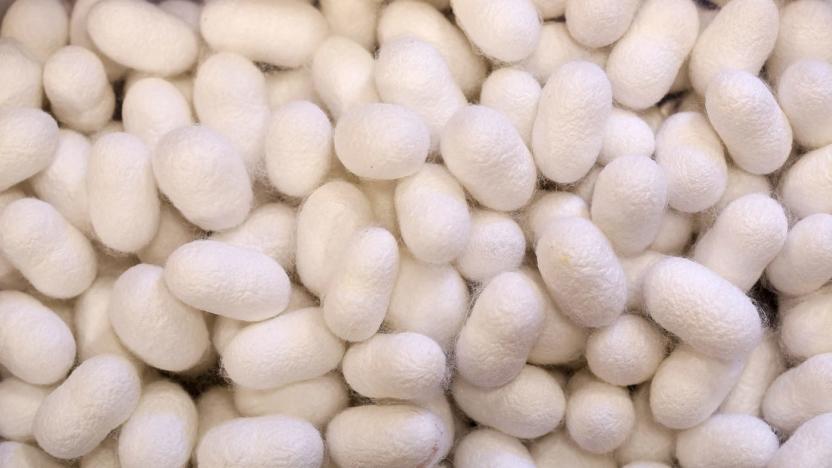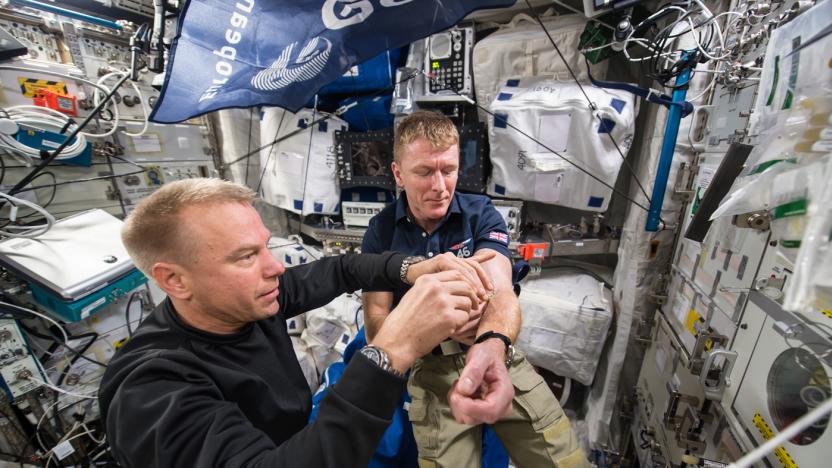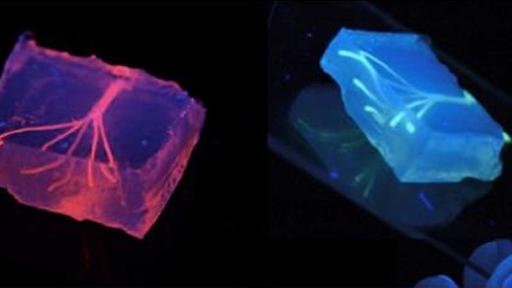blood
Latest

Researchers are using silk cocoons to store blood samples
When doctors draw blood for analysis, it's vital that the sample either be immediately examined or refrigerated. That's because the proteins which indicate various diseases will either be destroyed by enzymes in the blood or deformed by ambient heat. Either way, the sample quickly becomes useless if you leave it sitting out. However a team of researchers from Tufts University have developed a new way to store samples without having to put them on ice by using silkworm cocoons.

Gene test spots all known inherited heart conditions
You might never have to worry that you'll fall victim to a heart condition passed along by your family. Researchers have developed a blood test that can reliably detect all known inherited heart problems, like genetically-based arrhythmia -- if doctors know about it, they can spot it. Previous tests only looked at a handful of genes and were only useful in certain circumstances, but the new technique identifies flaws in all 174 genes linked to the potentially life-threatening issues.

Experiment to determine why astronauts feel weak back on Earth
Astronauts don't have it easy when they come home, and it's not just because of the change in gravity: their red blood cell production drops while they're in space, leaving them weakened on Earth. But why? That's what a Canadian experiment aboard the International Space Station hopes to find out. The research is testing red and white blood cell functions, as well as bone marrow fat levels, to see how they change before, during and after spaceflight. It should not only show how microgravity (and the resulting lack of activity) affects blood cells, but how reversible the effects are. How soon could you go back to normal?

Scientists 3D print 'live' blood vessels
It's no longer a rare feat to 3D print blood vessels. Printing vessels that act like the real deal, however, has been tricky... until now. Lawrence Livermore researchers have successfully 3D printed blood vessels that deliver nutrients and self-assemble like they would in a human body. The key is to print an initial structure out of cells and other organic material, and then to augment it with bio ink and other body-friendly materials. With enough time, everything joins up and behaves naturally.

Virtual wound will teach medics how to treat soldiers
Field medics have ways to practice their craft before they're helping soldiers on the battlefield, but it's hard for them to understand how wounds work until they're involved in a life-or-death rescue. UCLA scientists may have the tool these medics need, however: they've developed the first detailed injury simulation to show medics what to expect. The virtual gash could make you a bit queasy (sorry!), but it's uncannily accurate. A mix of fluid dynamics and in-depth mechanics (such as bones, skin and vessels) makes sure that blood flows much as it would from a real person.

3D-printed vascular systems help doctors practice for your surgery
It's safe to say that you want your doctors to know exactly what they're doing when performing surgery. But how do they train for a vascular operation, which is both extremely tricky and unique to your anatomy? By using 3D printing, that's how. MakerBot's parent company Stratasys is teaming with physicians to create 3D-printed replicas of patients' vascular systems, giving surgeons a way to practice before they poke around your blood vessels. The models use flexible photopolymers (that is, light-sensitive polymers) to recreate the feel of organic tissue, so you don't have to worry that the surgery team is only used to working with hardened plastic.

WSJ: Walgreens is waiting for answers about Theranos blood tests
Controversy has swirled around Silicon Valley startup Theranos ever since the Wall Street Journal reported the company has struggled to roll out its unique blood testing technology. Since 2013 Walgreens has partnered with Theranos to use it for blood testing in the Phoenix area, but now the Journal says the drugstore chain is looking for answers too. It claims that Walgreens found out from the reports that Theranos had stopped using its tiny "nanotainers" to collect blood for all but one type of test. In a statement provided to Engadget (you can read it in full after the break), Walgreens says "we are currently in discussions about the next phase of our relationship" and that the two are trying to figure out a mutually beneficial arrangement. Meanwhile, Theranos has maintained it is confident in the accuracy of its tests, and says that by being faster and cheaper they can identify health problems earlier.

Fizzy microparticles may save lives on the battlefield
Battlefield medics and paramedics rely on chemical-infused bandages to help stem blood loss and treat wounds. However, the blood itself is frequently their worst enemy -- it takes those chemicals away from where they're needed. Those first responders may soon have a much smarter solution, though. Researchers have developed bandages with a combination of powdered marble, acid and enzymes that fizzes on contact with blood, using the resulting bubbles to transport microparticles toward deeper vessels that need clotting. The particles currently travel in all directions, but scientists envision using an endoscope to send the fizz to where it's most useful.

Scientists aim to treat septic shock with new, meshy dialysis device
Sepsis is a mysterious condition. It's the body's life-threatening response to an infection and it's usually tied to a weakened immune system, but it can be triggered by just a cut or routine surgery. Each year in the United States, Sepsis affects more than 1 million people and kills up to half, according to the National Institutes of Health. There's no treatment for Sepsis or septic shock, the deadly full-body inflammatory response, but scientists at Harvard's Wyss Institute are working on a new dialysis system that cleans the blood of poisonous pathogens, Reuters reports.

UK plans world's first artificial blood transfusions by 2017
To better treat specialist patients, scientists have experimented with lab-grown organs and cells for some time. For the NHS, maintaining UK blood supplies is also high on the agenda, so it's been working to offset the fall in donations by growing its own. In fact, the health service says we may only be two years away from seeing the world's first artificial transfusions, which could potentially revolutionize treatment for seriously ill people with complex blood types.

A drop of blood reveals almost every virus you've ever met
This stock image is just for illustration, you do not need this much blood to take the new test. Every disease that you've ever encountered is cataloged within your DNA, and now a team from the Howard Hughes Medical Institute has worked out how to access that data. It's part of a project called VirScan that, it's hoped, will revolutionize medical testing and help Doctors catch illnesses long before they manifest. Even better, is that it's not even an expensive procedure, with each test slated to cost just $25 -- well, at least before your hospital slaps on their own fee on top.

The best way to draw a self-portrait is with your blood and a CNC machine
Snapping a selfie with your phone is easy enough these days, but in order to create a self-portrait, a Brooklyn-based artist chose a slightly different route. 44-year-old Ted Lawson hooked himself up to a CNC machine (which he refers to as a "robot") intravenously so that the device could draw a life-sized nude self-portrait with his blood. For the "Ghost in the Machine" work, Lawson had to remain connected to the output device while it plotted its marks to compose the sketch. "I'm generally not into doing selfies, particularly nude ones, but when I came up with the idea to connect my blood directly to the robot (CNC machine), it just made too much sense to not try one as a full nude self-portrait," he said. Lawson goes on to say that folks that may criticize his use of the machine for the piece, but leveraging the tool for drawing takes "just as much skill and practice to use as a pen." For a look at the process (obviously, not for the squeamish), head on past the break.

Trade blood for The Evil Within swag at QuakeCon
Quakecon attendees, don't forget to make sure your blood is topped off to participate in the American Red Cross blood drive for an official The Evil Within chill pack. "The Good Within Blood Drive" will take place at the Hilton Anatole Hotel in Dallas, Texas (the same location as the convention) on Friday, July 18 and Saturday, July 19. Those seeking to participate in the exsanguination can sign up in the Topaz room. You must be at least 17 years old and meet certain other requirements. QuakeCon 2014 will take place July 17 - 20 and participants can now enjoy the exclusive DOOM reveal with light-headed joy. [Image: Shutterstock]

Researchers are using 3D printers to make blood vessels
There has been talk of printing blood vessels for a few years, but it's tricky to make tissue that fits the complex shapes of a human body while remaining effective. However, a research team at Brigham and Women's Hospital may have licked that problem: they've 3D printed vessels using a new technique that allows for intricate yet capable designs. Their process first prints agarose (sugar-based molecule) fibers as templates for the vessels, and then covers that in jelly-like hydrogel to produce a cast. Since the agarose is sturdy, scientists can pull it out to create channels without damaging any cells inside the gel; the resulting vessels are much better at transporting liquid and otherwise behaving like the real deal.

Scientists reverse aging in mice by giving them young blood
Plots from The Simpsons are rarely prophetic, but it appears as if, just as it did for Mr. Burns, the blood of the young could help to stave off the signs of aging. Competing teams at Harvard, Cambridge and the University of California have found that pumping the blood of juvenile mice into elderly rodents saw the latter suddenly able to run much faster, had more blood vessels in the brain and had much clearer thinking. Harvard researchers subsequently isolated a protein called GDF11, which helped both the operation of hearts and brains. Given the limits of the study, the teams are cautious about what this could mean for human biology, and there's plenty of trials still to be done, but maybe it'd be wise to start being nice to any juvenile relatives you've got -- you never know when you might be asking them for a transfusion.

Mortal Online patch will add more blood and Oculus Rift support
Mortal Online is about to both look better and play better with the coming of Patch 1.80.00.00. Wait, is that a patch version or an IP address? Never you mind. The new patch contains a boat-load of tweaks and upgrades, including the switch to an updated Unreal Engine. The dev team has improved the UI, rebuilt the gathering system, added more custom helmet overlays, created a unified options system, and even added support for Oculus Rift rendering and control. And if you worried that Mortal Online might be losing its savage edge, then you'll be glad to read the following patch note: "Tweaked decapitation blood for more... blood." [Thanks to Graham for the tip!]

Diablo III welcomes you to the Blood Marsh
Blood Marsh: That doesn't sound too inviting, does it? But it does sound like something that would fit right in with Diablo III's cheery locales. It probably crushed the interview when it applied to be a zone in the game. Diablo III has a fetid and murky blog post today spotlighting the Blood Marsh region from the upcoming Reaper of Souls expansion. According to Blizzard, the Blood Marsh is "a massive, swampy stretch of land, split by rivers and tributaries often utilized for passage and trade." The theme of "blood," both the red substance and lineage, is integral to the zone's story. Adventurers in the region will discover signs of an ancient civilization, battle creatures like the bogans and blood golems, and unlock the mysteries of the Ruins of Corvus.

The Elder Scrolls Online receives Mature rating
The Entertainment Software Rating Board has given Elder Scrolls Online a Mature rating for "Blood and Gore, Sexual Themes, Use of Alcohol, and Violence," ZeniMax posted on its Facebook page. The studio is none too happy about the decision, stating, "The ESRB advised us that it has given The Elder Scrolls Online a Mature rating. While we may disagree with the ESRB's determination, we do not plan to challenge the rating, and we are unwilling to change the game's content to achieve a different rating. The game we have created is the one we want our fans to be able to play." ZeniMax said that the ruling has forced the studio to put the Mature rating and age gates on the ESO site, trailers, and ads.

New DLC adds buckets of blood to Total War: Rome 2
If Total War: Rome 2 proves a bit tame for your desensitized palate, we've got good news: Sega has released a new downloadable addition for the strategy game that will cause its battlefields to literally run red with blood. Appropriately titled "Blood and Gore," this DLC addition focuses on improving the brutality of combat in Total War: Rome 2. New sound and particle effects have been added alongside "hundreds of gruesome animations." According to Sega, both soldiers and the ground they fight on will now become increasingly spattered with blood and pieces of former people as combat rages on. As you'd expect, this bloody deluge earns the DLC an "M for Mature" rating. If that doesn't turn you off, you can feed your sadistic desires by purchasing the Blood and Gore DLC from Steam for $3.

uChek raises the stakes in smartphone health care with camera-based urine analysis
The iPhone. Is there anything it can't do? The trend towards self-monitoring and informal health tracking continues with uChek. Featured today over at Wired, this app enables you to automatically read, chart and track a variety of urinalysis tests on your iPhone. The product works by leveraging the iPhone's highly sensitive camera to read tints from inexpensive urine dip stick tests. Developed by Mumbai-based Myshkin Ingawale, an MIT grad, the app shifts monitoring away from expensive clinics and into the home. I do worry about lighting variation but I assume there will be calibration of some sort built into the test strips. It's still early days. The website is still creaky. I was unable to sign up for the email list and the shop, which will eventually sell the test strips for US$20 a package, hasn't gone live yet. Here's a TED talk from last year, where Ingawale talks about an earlier invention called ToucHb. It introduced blood tests without needles.









